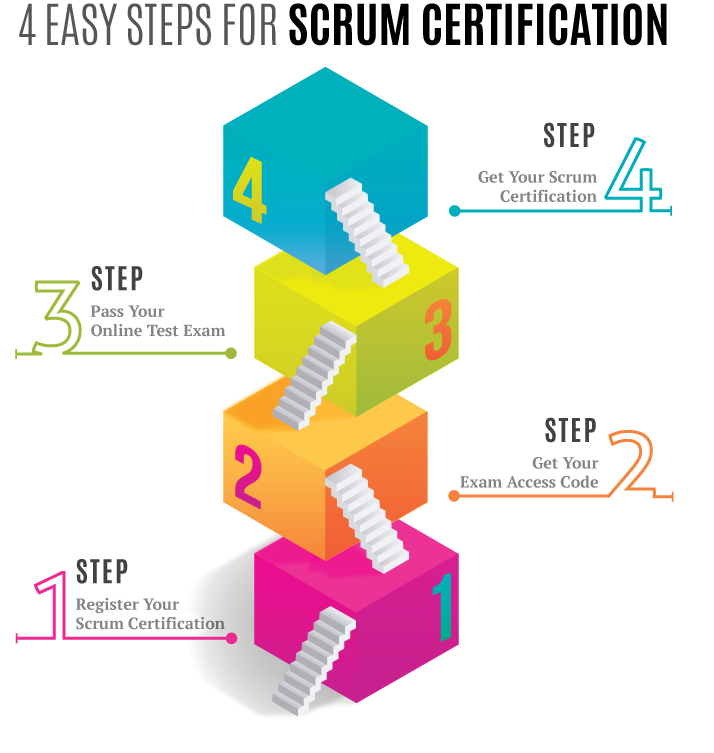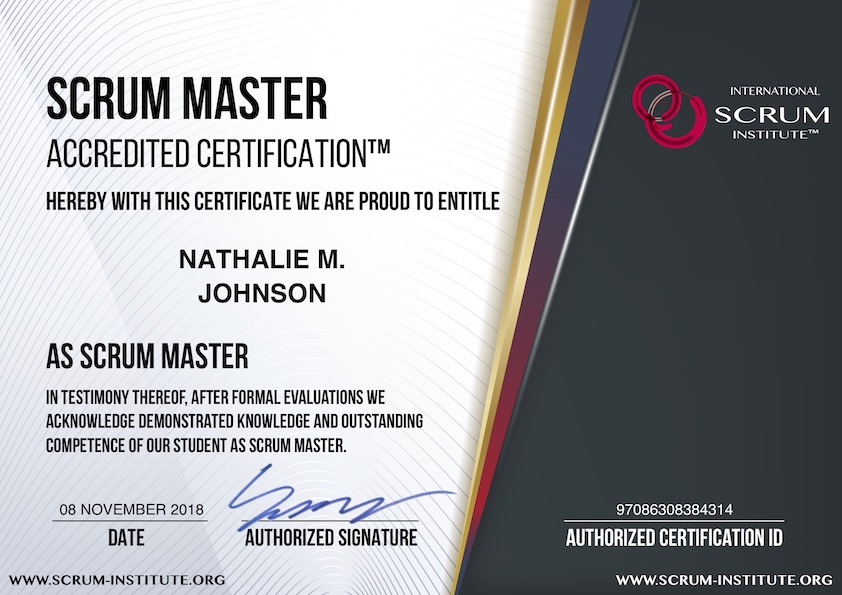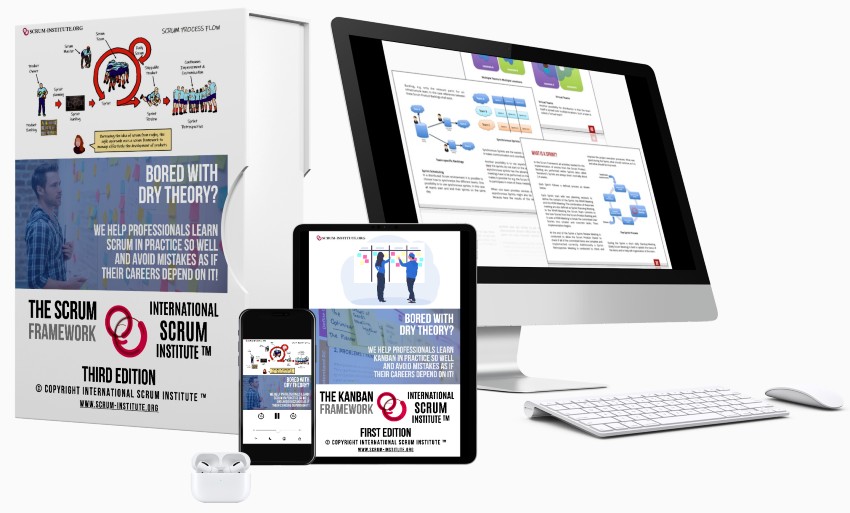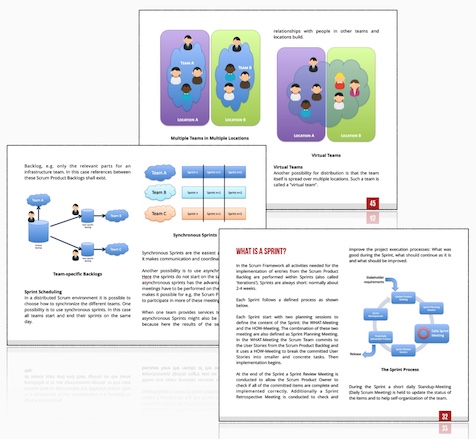Daily Scrum (Standup) Meetings:
The Meeting Guide
The Daily Scrum Standup Meeting is a crucial tool in Agile teamwork. Designed as a brief gathering, it fosters cooperation by helping teams synchronize their work, assess progress, and strategize for the day ahead. Yet it's not just another meeting; with its concise 15-minute format, it supports swift decision-making while avoiding long-drawn discussions. These essential meetings are everyday steps toward achieving overall project alignment. Let's delve into the world of these unique standup meetings.
Conducting an effective daily Scrum stand-up meeting involves keeping it timeboxed, focusing on the three key questions (What did I do yesterday? What will I do today? Are there any impediments?), and ensuring that it serves as a brief coordination opportunity rather than a problem-solving session. This approach fosters transparency, alignment, and timely issue resolution within the Scrum team.
What is the Daily Scrum Standup Meeting?
Daily Scrum (Daily Standup) Definition: The Daily Scrum is a brief, time-boxed meeting within the Scrum framework where the development team synchronizes their work, discusses progress, and identifies any impediments to foster collaboration and adaptability.
The concept of a Daily Scrum Standup Meeting might sound quite formal, but it's really a simple and powerful practice in Agile project management. This meeting is a cornerstone ritual where team members meet to discuss progress, plan for their day, and ensure everyone is working in tandem. It's basically a quick check-in to keep everyone on the same page and address any potential roadblocks or issues.
The word "standup" might make you think of actually standing up during the meeting, and that's exactly what people often do. The idea is to keep the meeting short and focused—when people are standing, they tend to be more alert and keep conversations precise and concise.
One thing I've learned over time is that this morning meeting should not turn into a problem-solving session. It's about sharing updates so everyone knows what's happening with each team member.
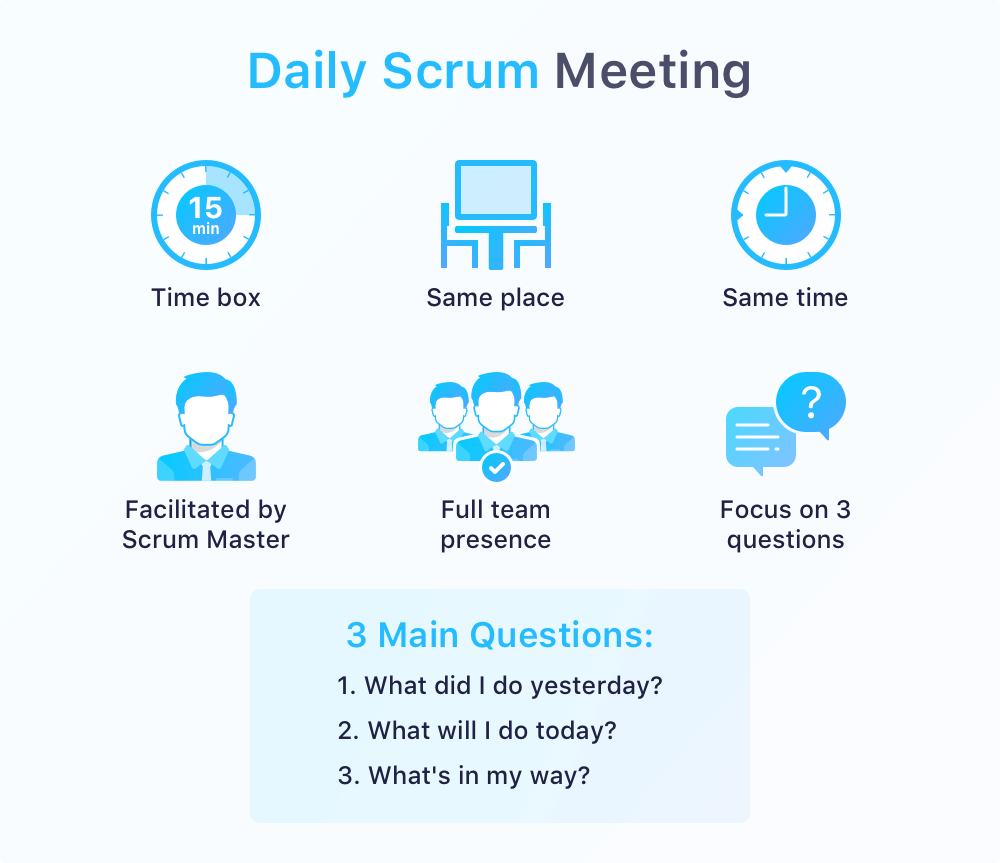 Daily Scrum (Daily Standup) Meeting
Daily Scrum (Daily Standup) Meeting
How Daily Scrum Meetings Work
In a typical Daily Scrum Standup Meeting; each team member answers three questions:
- What did I work on yesterday?
- What am I working on today?
- Are there any obstacles in my way?
It gives everyone a quick snapshot of what tasks need to be done and any issues someone might be facing.
For instance, imagine you're building a house. During the standup, the carpenter would say, "Yesterday, I finished putting up the framework for the porch. Today, I'm going to start laying down the deck boards. My only obstacle is waiting for the delivery of more wood."
That level of communication helps everyone understand what's happening at every stage of the project. A good tip is to try and have these meetings at the same time and place every day—it’s surprising how much more organized things feel when everyone knows exactly when and where they'll be discussing their work!
In essence, the daily Scrum standup meeting is all about keeping teams in sync, fostering collaboration, and ensuring everyone is moving forward in unison. It serves as a critical pulse-check to prevent any inefficiencies and align efforts towards reaching project goals.
Participants of a Daily Scrum Standup Meeting
Imagine the daily stand-up meeting as a stage. There are three main roles present on this stage: The Scrum Master, the Product Owner, and the Development Team.
Scrum Master
The Scrum Master is at the center of it all. They wear many hats—they're a coach, a mentor, and even sometimes a cheerleader for their team. During the standup meeting, the Scrum Master runs the show. They facilitate the meeting to make sure it stays focused on the key topics and doesn't spiral off track.
They also ensure that if anyone mentions any obstacles or issues they're facing, those impediments are removed after the meeting. Think of them like a fixer in a movie—they help solve problems and make sure everything runs smoothly.
A good Scrum Master is like a director ensuring that every actor (or team member) knows their lines and is prepared for their role in making the performance (or project) successful. This helps in creating a platform for effective communication and collaboration among team members.
Product Owner
The Product Owner joins these meetings to get a firsthand look at how the project is progressing. Their insights and feedback from the perspective of product delivery are incredibly valuable. By being involved in these discussions, they have an opportunity to offer guidance based on their understanding of customer needs and market demands.
Additionally, the Product Owner can provide clarifications or adjustments to requirements that might come up during discussions. This ensures that the team is aligned with the product vision throughout the development process.
Scrum (Development) Team
Finally, we have the heart and soul of the stand-up—the Scrum (Development) Team. These are the individuals who dedicate their energy and expertise to getting things done. Each member showcases what they've been working on, what challenges they're facing, and crucially, if there are any potential impediments standing in their way.
It's like each person has a puzzle piece, and during the stand-up meeting, they get together to see how each piece fits into the bigger picture. This transparent communication allows everyone to be aware of what others are doing, share knowledge, and rally around each other to push towards success.
In essence, when every participant fulfills their role effectively within these standup meetings, it paves the way for collaboration, transparency, and problem-solving—an essential trifecta in Agile project management.
As team dynamics and member roles play a pivotal part in Agile project management, understanding them better becomes crucial for seamless teamwork. Let's now shift our focus to explore how roles are distributed among team members for optimal project execution.
Role Distribution Among Team Members
In a well-organized Scrum standup meeting, each member is expected to carry out a specific role for smooth communication, time management, and record-keeping.
Speaker
The first key role is the speaker, responsible for delivering updates and sharing any potential roadblocks they are facing. They provide succinct but meaningful status reports on what they accomplished yesterday, what they plan to work on today, and if there are any impediments in their way. The speaker's updates should be focused, highlighting any dependencies or challenges they foresee.
Timekeeper
Another integral role is that of the timekeeper. This individual ensures that discussions remain within the predetermined time frame—typically 15 minutes for a standard Daily Scrum meeting. The timekeeper raises a gentle reminder when discussions start to veer off track, allowing every team member to contribute effectively within the allocated time.
Note-taker
The note-taker holds an essential position as they record key points discussed during the meeting. These notes help maintain a record of progress made, impediments faced, and any commitments made by team members. It's crucial that the note-taker captures accurate and complete information to provide a detailed reference of what transpired during the meeting.
By assigning these clear roles to team members, the standup meeting gains structure and coherence, ensuring that it remains focused on achieving its core objectives—bringing everyone onto the same page, fostering collaboration, and identifying potential hurdles early on. Each member's designated role complements the others and collectively maximizes the meeting's impact.
Once these primary roles have been established in a Scrum standup meeting, it's essential to delve deeper into how these roles interact within the structure of such meetings.
The Structure of a Daily Scrum Standup Meeting
In the world of Agile project management, a daily standup meeting, also known as a daily Scrum, is like a quick huddle before the big game. It's a brief but significant part of the day where everyone on the team gets together to touch base and get in sync. Here's how it works.
Start with a Round of Updates
The key to a successful daily Scrum is this three-question round robin. Each team member takes turns answering the same three questions:
- What did I do yesterday?
- What will I do today?
- Are there any impediments in my way?
This isn't just about each person saying their piece; it's about setting the stage for collaboration and transparency. When you talk about what you did yesterday and what you'll do today, it helps everyone understand where things stand and how they connect to one another. If anyone is stuck or facing challenges, this is the time to speak up.
Addressing Impediments
This is where the magic happens—when the team puts their heads together to tackle roadblocks. If someone mentions an impediment during their update, it's time for proactive problem-solving. The Scrum Master and the rest of the team collaborate to address and resolve these issues efficiently.
It also shows that every member's work matters and that any challenges faced are important to all members of the team—fostering a real sense of unity in working towards shared goals.
Keep It Time-Bound
The time constraint might seem rigid, but it serves a crucial purpose. By keeping the meeting time-bound (usually 15 minutes or less), everyone stays focused on delivering concise updates without delving into unrelated details or deep discussions. It ensures that discussions are kept relevant, enabling team members to express themselves clearly and effectively without getting bogged down by unnecessary minutiae.
A time-bound approach aligns with Agile's core values of prioritizing individuals and interactions over processes and tools—promoting effective communication, productivity, and collaboration within the team. It also emphasizes the importance of punctuality and respecting each other's time—a small but valuable aspect that contributes to a healthy team environment.
By adhering to this structured approach, teams can ensure clarity, alignment, and responsiveness in their daily activities—key ingredients for Agile project management success.
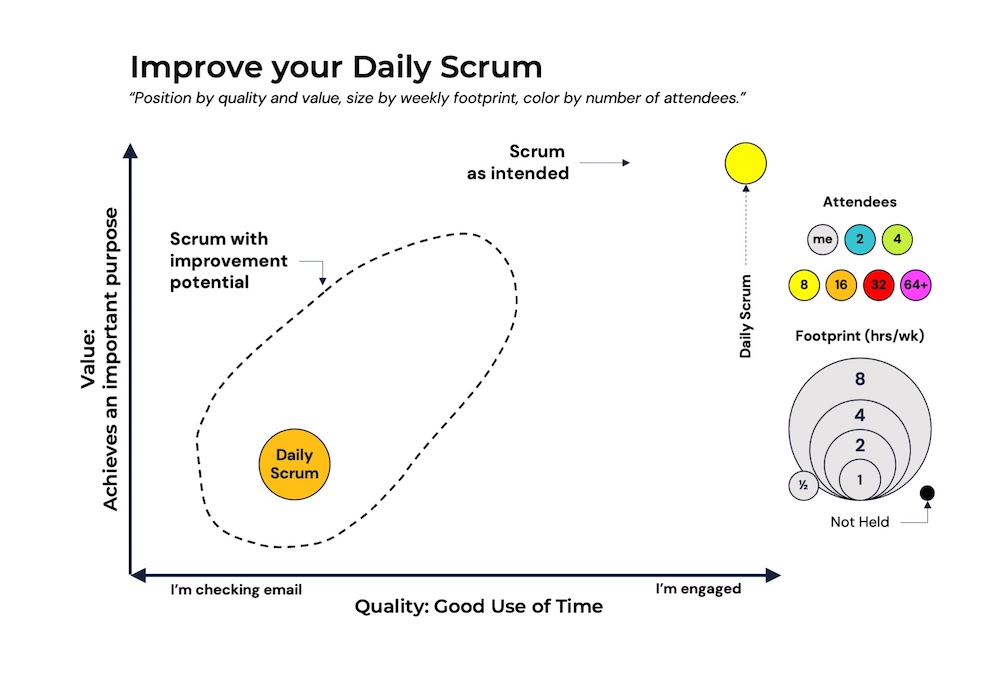
Progress Tracking in Standup Meetings
At the core of every successful daily Scrum standup meeting lies the real-time tracking of progress. It's akin to having a GPS system for your project – it helps you know where you are and where you need to be. This practice enables everyone on the team to stay on course while being fully aware of any hurdles or bumps along the way, fostering proactive problem-solving and continued forward momentum.
This form of tracking is truly proactive. It's not just about noticing when things go wrong but also recognizing potential issues early and steering clear of them before they become big problems. In a way, it acts as a safety net for the project, catching small issues before they snowball into bigger ones.
Imagine this: Your team member mentions a task that was supposed to be completed yesterday but is still underway. This insight alone can lead to a discussion on why it's taking longer than expected, if there are any blockers, and what can be done to help. By addressing this early in the day, it's possible to provide support, adjust timelines, or make necessary changes swiftly - preventing possible delays.
Furthermore, habitual tracking of progress during these meetings prevents bottlenecks from forming. When everyone knows what’s happening with each task every day, they can coordinate their work seamlessly and ensure that no one is waiting on something to move forward with their responsibilities.
Proactive Problem-Solving: By identifying deviations or potential delays immediately, teams can collaborate to solve problems faster and prevent disruptions to the project's flow.
For instance, if John is waiting for feedback from Maya to complete his part of the project, he might bring it up during the standup meeting. This brings awareness to everyone and gives them an opportunity to address the issue so that John isn’t blocked for long.
By continuing to track progress over time, teams build an archive of data that can be incredibly valuable for future projects as well - allowing them to see patterns, understand what works, and learn from past mistakes.
In summary, real-time progress tracking during standup meetings serves as a crucial tool for maintaining project momentum and enables teams to identify potential issues early on, leading to proactive problem-solving and enhanced collaboration among team members.
As we’ve seen the pivotal role of daily scrum in keeping projects sailing smoothly, next we'll explore the key benefits and advantages of these enlightening sessions.
Key Benefits and Advantages of Daily Scrum Meetings
Daily Scrum meetings offer several significant advantages that directly impact project success. Let's delve into the key benefits of these daily standup meetings in Agile project management.
Improved Transparency
One of the most powerful aspects of daily Scrum standup meetings is the transparency they provide. When team members regularly share their progress, challenges, and plans with each other, it fosters a culture of accountability and collective ownership. This transparency ensures that everyone is aware of what's being worked on, what's completed, and any potential roadblocks.
Consider this scenario: Each team member provides an update on their tasks, enabling others to understand how individual efforts contribute to the overall project progress. This not only helps in identifying potential bottlenecks early but also encourages open communication and trust within the team.
Enhanced Collaboration
The regular interaction during daily Scrum meetings strengthens team collaboration by providing a platform for sharing insights and aligning efforts seamlessly. As team members discuss their work, they naturally gain a better understanding of each other's areas of expertise and can leverage this collective knowledge effectively to overcome challenges and optimize solutions.
Moreover, collaborative problem-solving often arises during these meetings – one member might offer a fresh perspective on another's issue, or suggest an innovative approach that someone else hadn't considered. This free flow of ideas builds a sense of shared responsibility and creates a space for productive brainstorming sessions.
Quick Issue Identification
In addition to promoting openness and collaboration, daily Scrum meetings facilitate quick issue identification. By bringing forward any impediments or challenges at the start of each day, teams can promptly address these issues, minimizing their impact on project timelines and ensuring smoother workflow.
For instance, if a team member encounters a roadblock while working on a particular task, they can immediately bring it up during the meeting, allowing the collective brainpower of the team to come up with possible solutions or allocate resources to resolve it efficiently. This proactive approach prevents small issues from escalating into major problems and keeps the project on track.
With improved transparency, enhanced collaboration, and quick issue identification being substantial benefits of daily Scrum meetings, it's clear that these daily gatherings are more than just status updates; they are a cornerstone in Agile project management for fostering teamwork and productivity.
Each day presents new possibilities to refine strategies for effective participation in these crucial Scrum meetings. Now, let's uncover valuable tips for maximizing the impact of these collaborative sessions.
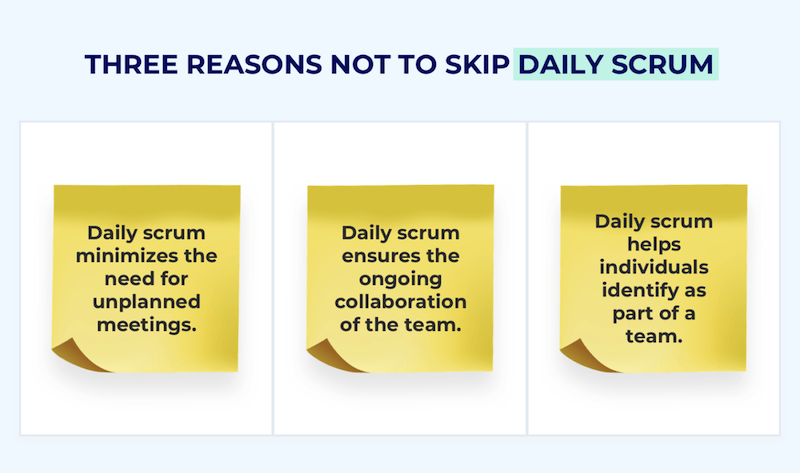 Daily Scrum (Daily Standup) Meeting Benefits
Daily Scrum (Daily Standup) Meeting Benefits
Strategies for Effective Scrum Meetings
Encouraging Participation
To cultivate an environment where every team member feels comfortable sharing their progress and voicing their concerns, transparency and participation are key. It's crucial to express appreciation for each team member's input, fostering a culture of collaboration and support within the team, which is essential for successful Scrum meetings.
Moreover, as a Scrum Master or facilitator, employing techniques such as asking specific questions can engage individual team members and ensure that everyone has an opportunity to speak. For example, you can ask what they accomplished yesterday, what is planned for today, and if there are any obstacles hindering their progress. This approach encourages participation and helps identify potential roadblocks early on.
Limiting Distractions
Whether the Scrum meeting is virtual or in person, minimizing external disturbances is important for focused discussions. In a physical setting, choose a dedicated space for meetings where distractions are minimized and the environment is conducive to open communication.
In virtual environments, encourage team members to join the meeting from a quiet location, utilizing technology tools for effective virtual communication and collaboration. Reminding participants to silence their phones and turn off notifications can help maintain focus during the meeting.
By implementing these strategies, Scrum Masters or facilitators can create an engaging and productive atmosphere for daily standup meetings that encourage active participation from all team members and help maintain focused discussions, ultimately contributing to Agile project success.
Mastering the art of conducting effective standup meetings is pivotal to the success of Agile projects. Now, let's delve into the action steps that follow these essential daily gatherings.
Action Steps Post-Standup Meetings
So, you've had your standup meeting, everyone is in the loop about what's happening, and now it's time to get things done. What comes next is just as important as the meeting itself – taking action. This means that impediments or challenges that were identified need to be dealt with, and everyone needs to be working together towards the daily goals that were discussed. It's like taking the energy from the meeting and making something meaningful out of it.
First off, any impediments that were brought up need to be addressed promptly. Whether it's a technical issue, a resource problem, or a roadblock in the project flow – it should be dealt with before it becomes a bigger problem. If someone can't proceed because of a dependency on another team member, this needs quick attention. For instance, say the developer mentioned at the meeting that they are stuck because they are waiting for design specifications from the designer. Immediately after the meeting, the scrum master could facilitate a conversation or send a gentle reminder to the designer about this to make sure everything stays on track.
After taking care of these impediments, each team member can focus on their daily tasks with more clarity and speed. This means that if actions are taken right after the standup meeting, a lot less time will be wasted in getting things done during the rest of the day.
Additionally, maintaining a record of these actions helps in tracking progress and performance over time.
Let's say one of the team members mentions an issue with software compatibility during the meeting. The scrum master could then assign another team member to research solutions for this issue and report back within a specific timeframe. By keeping track of these actions and their outcomes, you're not just resolving immediate problems - you're also building a more efficient workflow for future tasks.
Each action taken post-meeting should contribute towards achieving those daily goals. Think of them as small milestones that collectively lead you towards completing your project successfully in the long run. It is this consistent alignment of efforts following standup meetings which makes them so powerful for Agile project management.
Remember, great standup meetings are about fostering communication and setting clear paths forward. But without actionable follow-ups and measurable progress tracking, the value diminishes over time.
So as you can see, taking focused action after a standup meeting is critical in ensuring continuous progress and success throughout your Agile projects.
In conclusion, maintaining momentum post-standup meetings plays a pivotal role in driving Agile projects forward and maximizing productivity. Keep harnessing those actionable insights gained from these meetings to propel your team towards success! To delve deeper into effective Agile project management techniques, consider exploring our website for valuable resources.
What should be discussed during a daily scrum standup meeting?
Answer: During a daily scrum standup meeting, team members should discuss their progress since the previous meeting, any obstacles they are facing, and their plan for the day ahead. This helps to ensure transparency, collaboration, and adaptability within the Agile project management framework. According to a study by McKinsey, organizations that regularly held effective daily standups saw a 25% increase in project success rates compared to those that did not.
How long should a daily scrum standup meeting last?
Answer: A daily scrum standup meeting should typically last 15 minutes. This time frame encourages brevity and focus while fostering effective communication among team members. Research has shown that shorter meetings lead to increased productivity and engagement, with teams accomplishing more tasks and making better decisions. It is crucial to stick to the time limit and address any follow-up discussions separately to ensure the meeting remains efficient and valuable for everyone involved.
What are the benefits of holding a daily scrum standup meeting?
Answer: The benefits of holding a daily scrum standup meeting in Agile project management are numerous. Firstly, it promotes team collaboration and communication, ensuring that everyone is aligned and aware of the project's progress. Secondly, it facilitates quick problem identification and resolution, allowing for timely adjustments. Thirdly, it improves productivity by fostering accountability and transparency within the team. According to a study conducted by the International Scrum Institute, teams practicing daily scrum meetings reported an average increase in productivity by 25%. Moreover, it helps in managing risks effectively and encourages continuous improvement through regular reflection and adaptation.
How does a daily scrum standup meeting work?
Answer: A daily scrum standup meeting is a short and focused gathering of the project team where each member answers three questions - What did I accomplish yesterday? What will I do today? Are there any obstacles in my way? The purpose is to keep everyone on the same page, identify any issues that need attention, and promote collaboration. Research shows that teams that consistently hold daily scrum standups are more likely to complete projects on time and with better quality. According to a study by McKinsey, 86% of organizations reported improved project outcomes after implementing daily scrum meetings.
Are there any best practices for conducting a successful daily scrum standup meeting?
Answer: Yes, there are several best practices for conducting a successful daily scrum standup meeting in Agile project management. Firstly, ensure that the meeting is time-boxed to 15 minutes to keep it focused and efficient. Secondly, encourage team members to answer three key questions: what they completed yesterday, what they plan to do today, and any blockers or impediments they are facing. Thirdly, stand up during the meeting to keep it brief and minimize distractions. According to a survey conducted by the Scrum Institute, teams that follow these best practices have reported a 30% increase in productivity and better collaboration among team members.
What is a daily stand up meeting (Daily Call)?
Answer: A daily stand-up meeting, also known as a Daily Call, is a brief and regular gathering within Agile development teams. Developers participate in this meeting to discuss progress, plans, and challenges. It adheres to Agile principles, fostering collaboration and communication. It occurs during each iteration or sprint and serves to enhance efficiency by providing a forum for team members to share updates, align on goals, and address any impediments. The focus includes reviewing the sprint backlog, discussing tasks completed, and planning for the day, contributing to a dynamic and adaptive iterative development process.
What is the goal of Daily Scrum Meeting?
Answer: The goal of the Daily Scrum Meeting, as outlined in the Scrum Guide, is to facilitate coordination and collaboration within the development team. This timeboxed event, typically of 15 minutes duration, allows team members to discuss progress, plan for the day, and identify potential obstacles. It is not a problem-solving session but serves to ensure everyone is aligned and can adjust their work accordingly. The focus is on the upcoming work and how to achieve the sprint goal. The Daily Scrum does not involve stakeholders but encourages open communication among team members, setting the stage for continuous improvement, which is further addressed in the Sprint Retrospective.
Who all participate in Daily Scrum Meeting?
Answer: The Daily Scrum Meeting involves the Scrum Team, which includes developers, scrum master, and product owner. Managers typically do not participate actively in the Daily Scrum, as it is primarily a forum for the Scrum Team to discuss progress, impediments, and plan the day's work. The focus is on collaborative communication within the team, addressing tasks, and not on managerial oversight. During the meeting, team members may discuss user stories, story points, and any challenges encountered, ensuring alignment with the overall product goals.
Recap For Daily Scrum Standup Meetings
The daily Scrum meeting is a short everyday meeting, ideally during start of the working day. Each team member who works towards the completion of a given sprint needs to participate. During this meeting, each team member should briefly provide the answers of the following three questions.
- What has he/she accomplished since the last daily Scrum meeting?
- What is he/she is going to accomplish until the next Scrum meeting?
- What are the impediments that prevent him/her from accomplishing his/her tasks?
All team members should attend and they should stand during the meeting. The daily Scrum meeting should ideally not last more than 15 minutes. On the other no issues or concerns raised during the meeting are allowed to be ignored due to the lack of time. Issues or concerns ought to be recorded by the Scrum Master and needs to be specifically handled after the meeting.
Share It With Your Colleagues and Friends to Help Them Learn:
Daily Scrum (Standup) Meetings: The Meeting Guide
|
|

|

|

|

|
|
 SCRUM INSTITUTE™
SCRUM INSTITUTE™



